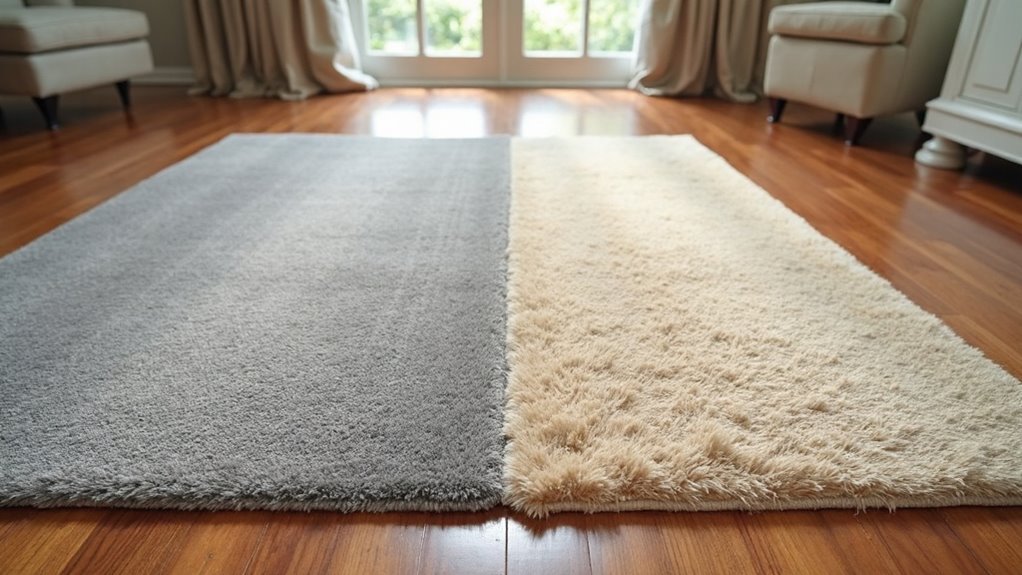Are you struggling to choose between nylon and polyester carpet for your home? You’ll want to make an informed decision that balances performance, comfort, and budget. Each material brings unique advantages to your living space, and the wrong choice could cost you in durability, maintenance, and long-term satisfaction. Before you commit to either option, there are critical factors you need to understand that can dramatically impact your home’s flooring investment.
Durability and Performance
While durability might be a top consideration for homeowners, understanding the performance characteristics of nylon and polyester carpets can help you make a more informed decision.
Nylon stands out as the more resilient option, offering superior resistance to crushing and matting. It’ll maintain its shape and appearance longer, especially in high-traffic areas of your home.
Polyester, on the other hand, provides decent performance at a lower price point but won’t hold up as well under heavy use.
If you’re looking for a carpet that’ll withstand years of foot traffic and maintain its original look, nylon is your best bet. Its strong fiber structure means it’ll resist wear and tear more effectively than polyester.
You’ll find nylon carpets recover better from compression and show less signs of aging over time.
Stain Resistance and Maintenance
Beyond durability, carpet performance hinges on stain resistance and maintenance requirements.
Nylon and polyester carpets differ considerably in these areas. Nylon’s superior stain resistance stems from its ability to repel liquids more effectively, especially when treated with stain-resistant technologies. You’ll find nylon carpets easier to clean and more resilient against tough stains.
Polyester, while more budget-friendly, struggles with stain retention. Its fibers absorb spills more readily, making permanent staining a real concern. You’ll need to address spills immediately and use specialized cleaning techniques to prevent lasting damage.
Maintenance-wise, nylon requires more frequent professional cleaning to maintain its appearance and performance. Polyester demands less intensive care but may show wear and matting faster.
Choose based on your household’s specific cleaning capabilities and lifestyle demands.
Cost and Budget Considerations
Budget-conscious homeowners quickly realize that carpet selection isn’t just about aesthetics—it’s a financial calculation. Nylon and polyester carpets differ markedly in upfront and long-term costs.
Nylon typically demands a higher initial investment, ranging from $3 to $7 per square foot, while polyester offers a more wallet-friendly option at $2 to $5 per square foot.
Don’t be fooled by lower polyester prices, though. Nylon’s durability means you’ll likely spend less on replacements over time. Polyester carpets wear faster and might need earlier replacement, potentially negating initial savings.
Consider your traffic areas, household composition, and budget constraints when making your choice. If you’re looking for a budget-conscious option with moderate durability, polyester could work. For high-traffic zones requiring long-term performance, nylon’s higher upfront cost might prove more economical.
Comfort and Texture Comparison
Although carpet comfort might seem subjective, nylon and polyester offer distinctly different tactile experiences.
Nylon carpets typically feel firmer and more resilient underfoot, providing a structured and supportive sensation. They maintain their shape well and resist crushing, which contributes to a consistently comfortable walking surface.
Polyester carpets, in contrast, deliver a softer, more plush feel. They’re often more cushiony and can create a luxurious, sink-in texture that many homeowners find appealing.
The fibers tend to be more yielding, offering a gentler touch that can feel especially comfortable in bedrooms and living areas where you’ll walk barefoot.
Your personal preference for carpet texture will ultimately determine which material feels more comfortable in your specific living space.
Environmental Impact and Sustainability
When selecting carpet materials, environmental considerations increasingly influence consumer choices. Nylon and polyester carpets have distinct ecological footprints that you’ll want to understand before making a purchase.
Polyester carpets often use recycled plastic bottles in their production, which reduces waste and provides an eco-friendly advantage. They typically require less energy to manufacture compared to nylon.
Nylon, while less sustainable initially, can be more durable, potentially meaning fewer replacements and less long-term environmental impact.
Both materials can be recycled, though nylon’s recycling process is more complex. You’ll find that some manufacturers now offer take-back programs for carpet materials, allowing for responsible disposal and repurposing.
Consider your priorities: immediate environmental impact or long-term sustainability through durability.
Conclusion
When deciding between nylon and polyester carpet, you’ll need to weigh your priorities. If durability and long-term performance matter most, nylon’s your best bet. But if you’re watching your budget and want a softer feel, polyester could be the way to go. Consider your home’s traffic, maintenance preferences, and personal style to make the right choice for your living space.
